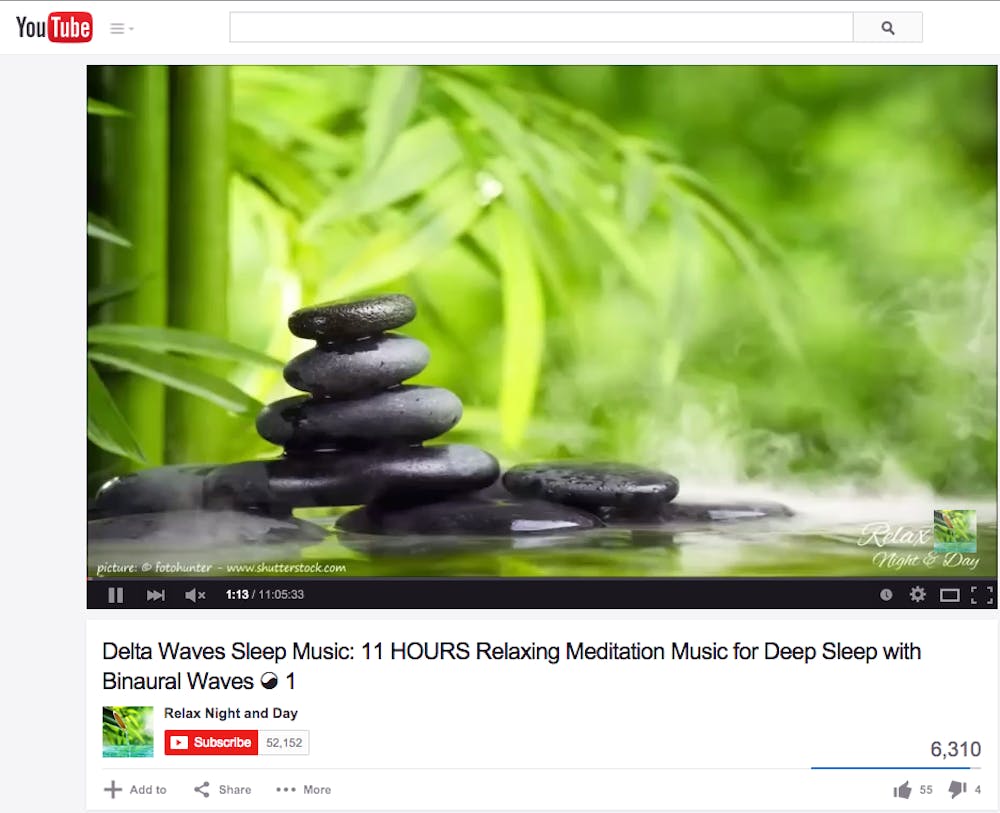For most of us, the YouTube experience consists of a downward–spiral into TV reruns, bad talk show clips and suggestions for weird shit based on your recently watched videos. But for more serious internet aficionados, YouTube offers a place for self–discovery. Mainly through three hour guided meditation videos. The videos are a bit different from the Vines or three–minute viral videos we usually watch. Viral videos are short and to the point. YouTube meditation is a healthy break from cat videos. For the uninitiated, it may be helpful—though hard—to define YouTube meditation.

The videos freely steal from myriad and diverse sources—including Asians and drugs. The instructions recommend headphones and usually require you to sit alone on your bed, eyes closed, trying to think about absolutely nothing. “Body Mind Zone” is just one video in the sea of YouTube accounts dedicated to the journey for spiritual fulfillment. Others include “Ultimate Relax Club,” “Spiritual Moment,” or any number of synonymous ac- count names. Each meditation account puts its own spin on the ancient art form: “Body Mind Zone” focuses on sleep and dream–like relaxation music, while “Make Your Future” has a more Asian– minimalist feel with abstract sound patterns in lieu of melody. And people are buying into this meditation hype. On the most popular meditation accounts, six to eight–hour videos are uploaded weekly, usually garnering 80,000+ hits, with the most popular watched by over ten million.
 One
could ask a lot of questions about the popularity of YouTube meditation, but
most could be captured in a single interrogative: Why? Why do millions of
people continually listen to eleven–hour videos on YouTube? Why do these
YouTube accounts mupload tons of videos that all sound virtually the same? If
YouTube didn’t limit video length to eleven hours, would people spend even more
time plugged into meditation? People listen for all sorts of reasons: to sleep
better, to relax, to cure anxiety, to “see what dreams I can get from this.” It’s
difficult to pinpoint what exactly makes these virtually silent, four– hour
videos so worthwhile. The only valid conclusion seems to be that listeners want
some kind of virtual peace. It’s not exactly a conventional, silent peace, but
rather a kind of ambient sound that gives calm.
One
could ask a lot of questions about the popularity of YouTube meditation, but
most could be captured in a single interrogative: Why? Why do millions of
people continually listen to eleven–hour videos on YouTube? Why do these
YouTube accounts mupload tons of videos that all sound virtually the same? If
YouTube didn’t limit video length to eleven hours, would people spend even more
time plugged into meditation? People listen for all sorts of reasons: to sleep
better, to relax, to cure anxiety, to “see what dreams I can get from this.” It’s
difficult to pinpoint what exactly makes these virtually silent, four– hour
videos so worthwhile. The only valid conclusion seems to be that listeners want
some kind of virtual peace. It’s not exactly a conventional, silent peace, but
rather a kind of ambient sound that gives calm.

To be honest, it works. YouTube meditation gives you an avenue to reflect on your life outside the context of Penn. A day on campus always feels like you’re running from place to place, never considering what it’s like to be in the actual moment. YouTube meditation creates a place for that. And it’s not just visiting that place; it's considering it. It’s at a space inside yourself that allows you to detox from everything that’s outside of your headphones. It’s just you and your YouTube account, and at a certain point between thirty minutes and an hour, just you. I haven't made it to the 11th hour of listening yet, but listening for an hour feels significant. It’s a departure from videos trying to fight for your attention. It’s a different way of bettering yourself than the usual methods of clubs and academics at Penn in that it requires large amounts of doing “nothing.” People always talk about escaping the Penn bubble and looking at reality outside of Penn. But YouTube meditation can help you leave Penn without ever leaving your dorm room.

